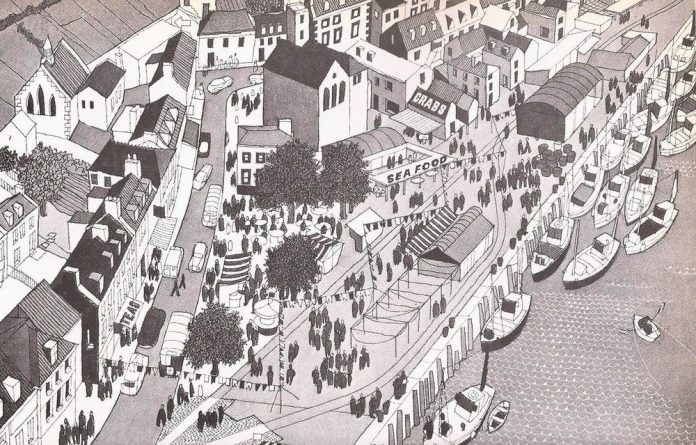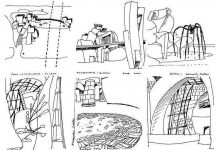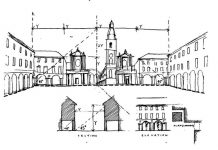The townscape movement emerged after the Second World War as a way of looking at how towns grew organically and how planners should respect the visual richness produced by this organic growth. Although primarily a British movement, it had a wide influence as an alternative to the modernist attitude to looking at towns and redeveloping them.
Like many generations before them the architects of the modern movement had clear ideas of their perfect city. For most it was a city built from scratch, full of modernist towers and planned in zones—an area for work, another for play, another for housing. For most, it was also an ideal in which traffic was separated from pedestrians, a place of urban freeways and soaring overpasses.
Reconstruction
After the Second World War architects and planners had their chance to put these theories into practice. If not entire cities, large swathes of towns and big new estates began to rise up where wartime bombing had given builders carte blanche. For many this was a brave new world in which towns, most of which had grown haphazardly over the centuries, could be properly planned for the first time.
This outlook resulted in the transformation of many cities—the 1950s’ redevelopment of central Boston with its urban freeways, for example, or, in Britain, the construction of vast housing estates around cities such as Birmingham, not to mention the logical, grid- based planning of new towns such as Milton Keynes.
“… if at the end of it all the city appears dull, uninteresting and soulless, then it is not fulfilling itself. It has failed. The fire has been laid but nobody has put a match to it.” Gordon Cullen, The Concise Townscape
Learning from the past
But not everyone saw urban planning in this way. For some, the old haphazard way in which towns had grown, with their mixture of architectural styles and often narrow, winding streets, was a good thing. It was visually stimulating and indicative of a culturally rich past. Perhaps surprisingly, one place where this alternative view was voiced was Britain’s Architectural Review—a leading journal that had often championed modernism. In 1944, with the prospect of the end of the war at last realistic, its editor, Ivor de Wolfe, called for a more diverse, pluralistic approach to town planning.
Ivor de Wolfe and his colleague Gordon Cullen saw that the general public would not take kindly to a “new Jerusalem, all open space and white concrete.” Planners should instead study what was good about our existing towns and cities. They should remember that the ideals of the 19th-century picturesque movement (see The picturesque), in which architects and gardeners placed buildings in landscapes with an eye on their artistic effect, could also be applied to urban settings. In other words, townscape was as important as landscape.
Explaining townscape
In articles in the Architectural Review and in books such as Townscape and The Concise Townscape, Cullen outlined these ideas. He spent a lot of time and space analyzing the buildings, streets, lanes and squares of towns, old and new, to demonstrate how they worked and what was good about them visually. With the aid of photographs and his own clear and evocative drawings, he showed how our experiences of urban spaces change as we move through them.
Urban features
Townscape identifies many features like those in the view of Oxford (below) that make city scenery distinctive. Here are a few of the most important.
- Focal point
Structures that form a focus—towers, statues, columns, crosses.
- Enclosure
Quiet, human-scale precincts, such as squares or courtyards.
- Viscosity
The way in which people “slow down”—to talk, meet, window- shop, buy a newspaper—in a healthy urban environment.
- Vista
The way in which the eye can be led through a scene—vistas may be open, grandiose or screened, for example, by trees.
- Punctuation and incident
Buildings and objects that catch the eye and give structure to a townscape.
- Scale
Our perception of the size and prominence of buildings and other structures.

Cullen was especially revealing about the variety of townscape—how different sizes of building, projecting and recessing façades, visual “incident” and “punctuation,” changing street widths, bends, curves and mysterious openings all enhance our experience of a town. And these features, of course, were quite the opposite of the uniformity proposed by most modernist planners.
Organic growth
The rich variety of cities that had grown organically, with their seemingly random mix of large and small, old and new buildings, entranced Cullen. And he was convinced that when others understood it, they would be entranced, too—the traditional organic city was for him an immense source of sheer visual pleasure. The opposite of this was what Cullen called “Prairie planning”: the same house design repeated endlessly against a background of uniformly wide streets, dull street furniture and featureless, unfenced gardens.
During the 1960s there was a running argument between the advocates of modernist planning and the followers of de Wolfe and Cullen, with their more pluralist approach. The modernists criticized Cullen for his emphasis on old cities. The townscape lobby attacked the modernists for the tedium and inhumanity of their plans.
Neither camp was wholly victorious. Many cities were redeveloped along modernist lines, but Cullen’s arguments were used by those favoring more sensitive and tactful development. But Cullen’s influence went further than this. He taught several generations how to look at towns more inquisitively and critically, and how to appreciate the way in which towns develop organically, and his work was followed up by later writers and journalists. Directly or indirectly, most of us are probably more aware of our urban surroundings because of the work of Gordon Cullen.



















